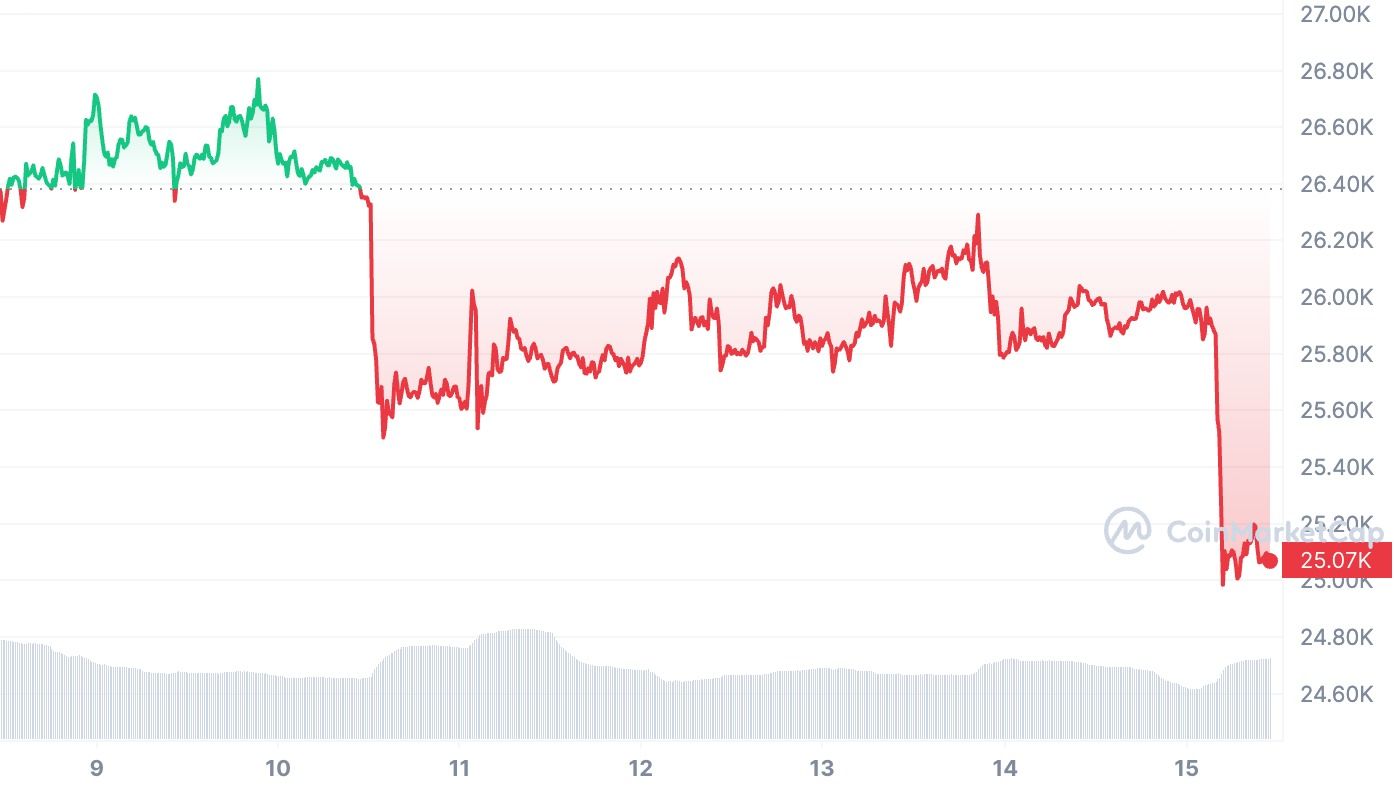Table of Contents
After ten consecutive rate rises over the past 15 months, the US Federal Reserve paused its aggressive tightening cycle on Wednesday.
But the US central bank left the door open for more rate hikes and forecasts significant rate cuts next year.
While markets had priced-in Fed rate cuts this year, bets from bond markets and traders have also moved to 2024.
Digital currencies fell, with Bitcoin dropping below US$25,000, losing over US$900 from its previous close. The world's biggest and best-known cryptocurrency is down nearly 20% from the year's high of $31,035 on April 14.

Ether, the coin linked to the Ethereum blockchain network, dropped below US$1,700, losing nearly US$100 from its previous close.
"Should we react to the Fed's pause or its hawkish tone is the question," said the chief investment officer at a large US asset management firm in Boston.
"But one thing is clear. There is no respite for digital assets amid extreme scrutiny by US regulators and now the Fed's forecast for two more rate hikes this year," added the CIO, who heads the firm with over US$2 trillion in assets under management (AUM).
While Fed policymakers anticipate price pressure to remain on a falling trend, Chairman Jerome Powell said it is too soon to declare inflation would continue declining.
"We have raised our policy interest rate by five percentage points, and we've continued to reduce our securities holdings at a brisk pace. We've covered a lot of ground, and the full effects of our tightening have yet to be felt in light of how far we've come in tightening policy, the uncertain lags with which monetary policy affects the economy and potential headwinds from credit tightening," said Powell.
"...we decided to leave our policy interest rate unchanged and to continue to reduce our securities holdings. Looking ahead, nearly all committee participants view it as likely that some further rate increases will be appropriate this year to bring inflation down to 2% over time," added the Fed's Chair.
Powell made these statements after the Open Market Committee, which sets Fed policy.
Inflation topping out
According to new predictions from Fed policymakers, borrowing rates are expected to rise to around 5.6% this year, which is more than what most economists and investors have been forecasting.
"What we'd like to see is credible evidence that inflation is topping out and then beginning to come down. That's - that's what we want to see. Of course, that's what we want to see," said Powell.
In addition, Powell said that virtually all Fed officials anticipate further rate hikes this year and that the July FOMC meeting is a "live meeting" that might result in another rate hike even if policymakers have not decided what they would do with rates at upcoming meetings.
The "extent of additional policy firming that may be appropriate" mentioned in the FOMC statement is a clear indication that policymakers will resume tightening, compared to the announcement made in May, which left greater room for whether or not to increase.
"If that's what they really believe, why not just hike? The breadth of hawkishness is a surprise. They state that the data will determine what happens next, but given these projections, the question arises: if you think the policy isn't tight enough, why not hike now?" questioned James Knightley, chief international economist at ING.
"July is a 'live' meeting, according to Powell, but a one-meeting pause makes little sense given the long lags involved with monetary policy. With the disinflationary trend set to accelerate, we see an extended pause," added Knightley.
Forecasts for economic growth and core inflation rose for 2023 while unemployment projections fell.
Even though the unemployment rate is low and job growth has been strong, the central bank maintains inflation is still "elevated."
Central banks in the Gulf, including Qatar and the United Arab Emirates, followed the Fed's decision to hold rates to protect their currencies' peg against the US dollar.
Hong Kong, too paused its rate hike cycle following the Fed's decision.
The pause in rate hikes, even if only a hawkish one, will give policymakers breathing room to see the lagged impact of aggressive tightening so far.
But for cryptos, the sentiment and regulatory scrutiny keep getting sour.
Unless there is a clear steer from the Fed and other major central banks on policy toward easing, there is a shortage of any boost to cryptos.
Like what you read? Our weekly Business Bulletin wraps up the most important business and economic developments in the industry, along with macroeconomic views and opinions. To avoid FOMO and access member-only features, click here to subscribe. It's free.






